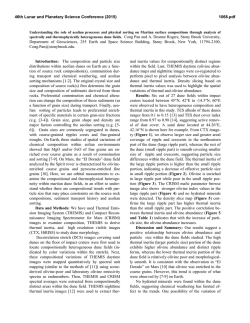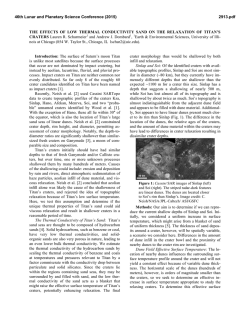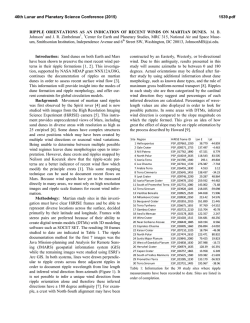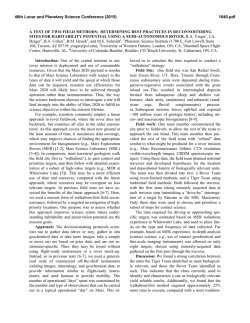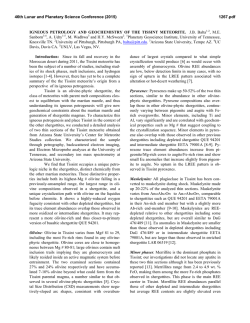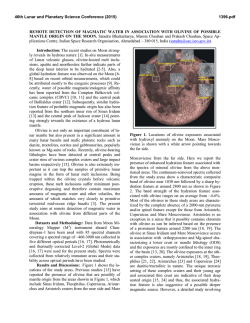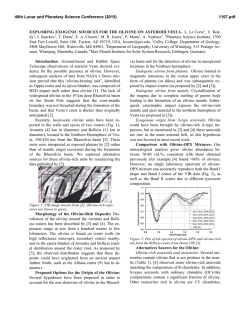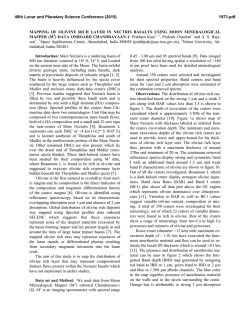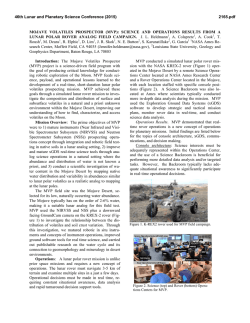
THE BAGNOLD DUNES AT GALE CRATER – A KEY TO READING
46th Lunar and Planetary Science Conference (2015) 1634.pdf THE BAGNOLD DUNES AT GALE CRATER – A KEY TO READING THE GEOLOGIC RECORD OF MOUNT SHARP. M.G.A. Lapotre1, B.L. Ehlmann1,2, F. Ayoub1, S.E. Minson3, N.T. Bridges4, A.A. Fraeman1, R.E. Arvidson5, J.L. Eigenbrode6, R.C. Ewing7, J.R. Johnson4. 1California Institute of Technology, Pasadena, CA, USA. 2Jet Propulsion Laboratory, Pasadena, CA, USA. 3USGS, Menlo Park, CA, USA. 4John Hopkins University, Laurel, MD, USA. 5Washington University in St. Louis, MO, USA. 6NASA/GSFC, Greenbelt, MD, USA. 7Texas A&M University, College Station, TX, USA. Introduction: The Curiosity rover is currently investigating the Pahrump Hills outcrop, which forms the basal part of the Murray formation at the base of Mt. Sharp. The Murray formation is exposed in cross-section for several kilometers, and at the center of this broad expanse of bedrock lays the informally named Bagnold dune field. A careful analysis of the chemical and mineralogic composition of the sands is important to interpreting the geologic record ahead, as the active sands may be the best protolith analog to the wind-blown sandstones the rover will encounter. Milliken et al. (2014) suggested that the lower stratigraphy of Mount Sharp is draped by aeolian sandstones, likely cemented by sulfates and/or clays, having preserved bedforms in places. Moreover, the basal units of Mount Sharp may also contain wind-blown sandstones, as indicated by exposed stratigraphy in a canyon of western Mount Sharp [1]. A key to understanding the past aqueous history of Gale Crater is to characterize the cementing phases, and in particular to discriminate between detrital and authigenic minerals. In the absence of thin sections, this question can only be answered if the composition of the protolith is well known. For example, the presence of clay aggregates in the dune-forming material would strongly argue against an authigenic origin. Orbital observations at Gale crater show that the dune field is active [2], and that olivine and/or pyroxene signatures are not homogeneously distributed in the Bagnold dune field [3] (Figure 1). Further visible and near-infrared orbital observations confirm that Martian winds sort mineral phases as they do on Earth [4-5], and we thus do not expect previously analyzed non-active sands (e.g., [6]) to be representative of the Bagnold dune field. A quantitative understanding of mineral sorting in the Bagnold dunes is thus critical for the interpretation of future CheMin, APXS, and other rover compositional datasets (e.g., SAM). Figure 1: (A) Olivine and high calcium pyroxene composite parameter map over barchans (B) and barchanoid ridges (C). This figure is from [3]. Note that longitudinal dunes are not observed in this scene but are observed further to the south west of the dune field. Hypothesis: The Bagnold dunes are a complex field, with both barchanoidal and longitudinal sections. Because of their different geometries and orientations with respect to transport direction, spatial grain sorting is expected to be different on barchan and longitudinal dunes (e.g., [7-9]). Barchan dunes generally have coarser material at the toe of the windward face. The lee face of barchan dunes is made of the material that mostly saltates (with some reptation and creep contributions) up the dune and then avalanches from the crest, and is thus made of the same, generally finer material as the bulk of the bedform. Longitudinal dunes have their slip faces alternating from one side to another, leading to approximately symmetrical grading, where grain size varies inversely with elevation on the dune: coarser material avalanches to the toe on either side and is remobilized again only by the strongest winds, while finer material saltates to the crest. Grain sizes at the crest of longitudinal dunes tend to be much more narrowly distributed than those at the crest of barchans [7]. Seelos et al. (2014) have observed an enrichment in olivine in barchan dunes, whereas barchanoid ridges seem to grade from pyroxene-rich at the toe of their windward face to olivine-rich towards their crests [3] (Figure 1). A possible explanation is that wind feels the roughness of the dune field at the upwind margin and slows as it moves towards Mount Sharp. Consequently, the barchans may concentrate coarser material because winds are capable of transporting the coarse grains there, but not further downwind, closer to the mound. In summary: (1) We expect the degree and patterns of mineral sorting to differ between barchan and longitudinal dunes of the Bagnold dune field, and (2) we expect coarser/denser grains to be found at lower elevations. The latter implies that mineral sorting and consequent chemical variations can be used as a tool to infer whether crossstratifications within Mount Sharp, which may represent preserved slip faces, are remnants of barchans or longitudinal dunes, and thus provide insights on paleo-wind directions, sedimentary transport, and mineralogic sorting. Methods: The scope of our work is three-fold. (1) We compare sand displacement maps derived from correlation of HiRISE images to mineral parameter maps derived from CRISM observations over the Bagnold dunes where Curiosity is expected to traverse in order to better identify endmember targets for the rover (Figure 2). (2) We make predictions of the modal mineralogy and grain sizes at the proposed target locations using Hapke’s bidirectional reflectance model [10] on DISORT atmospherically corrected CRISM data using approaches outlined in [11], combined with a Markov-Chain Monte Carlo (MCMC) algorithm [12] that allows us to map uncertainties of the inverted compositions. Finally, (3) we will test our predictions from orbital datasets with potential CheMin and APXS measurements once the Curiosity rover reaches the dune materials. Initial Results: Displacement-Spectral Properties Relationships: Initial observations over the barchanoidal portions of the dune field showed that sands that exhibit larger reptation fluxes (the portion of the flux contributing solely to ripple migration) also has more positive spectral continuum slopes from 0.7- 46th Lunar and Planetary Science Conference (2015) 1634.pdf expected traverse path are more complex, possibily dictated by the longitudinal morphologies in this location. For example, Figure 2 shows that in the aforementioned area, spectral continuum slope seems to be anticorrelated with reptation flux. This might reflect the effect of the olivine and/or pyroxene absorption bands on the continuum slope rather than that of a dust layer. Analyses are ongoing. Modal Mineralogies: Initial modeling of spectra from a large region of interest within the barchanoidal portion of the dune field [5] showed models roughly in accord with sand compositions measured by Curiosity. Modeled compositions were roughly 5 wt% olivine, 45 wt% pyroxenes, <0.5 wt% magnetite, and the remaining 50 wt% was either labradorite or a mixture of labradorite and an amorphous phase. Results were strongly influenced by whether or not amorphous basaltic glass was included, driving a new modeling approach that rigorously quantifies statistical probabilities of fits. Initial testing of the MCMC algorithm for basaltic compositions shows that the abundance uncertainty of a given mineral endmember is greater when its actual abundance is low, and can be as high as ±25 wt%. Future Work: Planning is underway for an in situ campaign at the Bagnold dunes to test these hypotheses and understand the role of aeolian transport in creating mineralogically and chemically distinctive sands. We expect the rover to measure compositional differences between at least two well-chosen targets in the Bagnold dune field. Combining CheMin and APXS data will allow us to discriminate between crystalline and amorphous phases, whereas SAM will allow us to analyze the least abundant phases as well as the coarser fraction of the sands (150 µm to 1 mm). ChemCam, with a LIBS spot size of less than 0.5 mm [13-14], should have the ability to measure the elemental composition of individual grains. Along with the other compositional datasets and images, such data will quantitatively constrain the degree of physical sorting that is attained under modern wind conditions, and thus provide a framework to interpret potential compositional trends in the stratigraphy ahead, as well as more generally, will inform our understanding of sandstones on the planet overall. Moreover, the Bagnold dune field campaign will be the first in situ investigation of any active dunes on another planet. Figure 2: (A) Sand displacements as derived from correlation of HiRISE images of ripples using COSI-Corr. The derived displacements thus correspond to grains moving in reptation only. (B) Spectral contiunnum slope derived from CRISM, DISORT-corrected data. Note that displacement and continuum slope tend to be anticorrelated. The white line represents the planned rover traverse. 2.5 µm [5]. We interpreted this trend as the effect of a bright dust layer covering the overall dark, mafic sands in areas where reptation fluxes are low. Dust cover enhanced the spectral reflectance most strongly in the near-infrared shortward of ~1 µm, thus resulting in negative continuum slopes for dusty bedforms. Note that corrosion of olivine might lead to similar observations from orbit, and the rover will be able to test this hypothesis through chemical analysis and imaging. However, subsequent analyses of orbital data over the portion of the Bagnold dune field closest to Curiosity’s References: [1] Milliken R. E. et al. (2014) GRL, 41-4, 1149–1154. [2] Silvestro, S. et al. (2013), Geology, 41, 483486. [3] Seelos K. D. et al. (2014) GRL, 41-14, 4880-4887. [4] Bridges N. T. et al. (2014), GSA Annual Meeting, Abstract #202-12. [5] Lapotre M. G. A. et al. (2014), 8th Conference on Mars, Abstract #1126. [6] Blake D. F. et al. (2013), Science, 341-6153. [7] Bagnold R. A. (1941). [8] Howard A. D. (1977), GSA Bulletin., 88. [9] Kok J. F. (2012), Rep. Prog. Phys., 75. [10] Hapke B. (1981), JGR, 86-B4, 30393054. [11] Arvidson R. E. et al. (2014), Science, 343, doi: 10.1126/science.1248097 [12] Minson S. E. et al. (2013), Geophys. J. Int., 194-3, 1701-1726. [13] Maurice, S. et al. (2012), Space Sci. Rev., 170, 95-166. [14] Wiens, R.C. et al. (2012), Space Sci. Rev., 95-166, 170, 167–227.
© Copyright 2025
